Solar eclipse of October 12, 1958
| Solar eclipse of October 12, 1958 | |
|---|---|
 Map | |
| Type of eclipse | |
| Nature | Total |
| Gamma | -0.2951 |
| Magnitude | 1.0608 |
| Maximum eclipse | |
| Duration | 311 sec (5 m 11 s) |
| Coordinates | 24°00′S 142°24′W / 24°S 142.4°W |
| Max. width of band | 209 km (130 mi) |
| Times (UTC) | |
| Greatest eclipse | 20:55:28 |
| References | |
| Saros | 133 (42 of 72) |
| Catalog # (SE5000) | 9417 |
A total solar eclipse occurred on October 12, 1958. A solar eclipse occurs when the Moon passes between Earth and the Sun, thereby totally or partly obscuring the image of the Sun for a viewer on Earth. A total solar eclipse occurs when the Moon's apparent diameter is larger than the Sun's, blocking all direct sunlight, turning day into darkness. Totality occurs in a narrow path across Earth's surface, with the partial solar eclipse visible over a surrounding region thousands of kilometres wide. Totality was visible in Tokelau, Cook Islands, French Polynesia, Chile and Argentina.
Related eclipses
Solar eclipses of 1957-1960
This eclipse is a member of a semester series. An eclipse in a semester series of solar eclipses repeats approximately every 177 days and 4 hours (a semester) at alternating nodes of the Moon's orbit.[1]
| Solar eclipse series sets from 1957–1960 | ||||
|---|---|---|---|---|
| Descending node | Ascending node | |||
| Saros | Map | Saros | Map | |
| 118 | 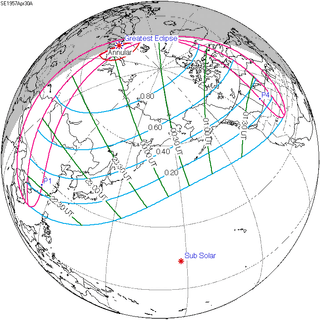 April 30, 1957 Annular |
123 | 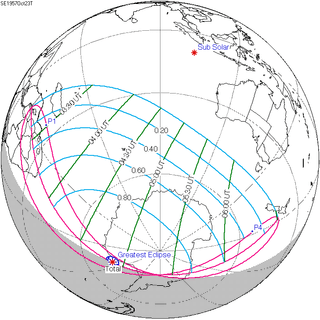 October 23, 1957 Total | |
| 128 | 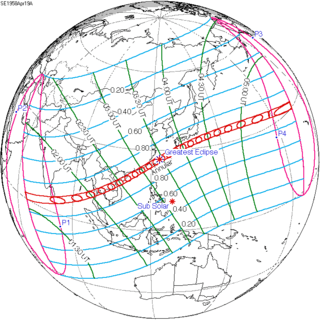 April 19, 1958 Annular |
133 |  October 12, 1958 Total | |
| 138 |  April 8, 1959 Annular |
143 | 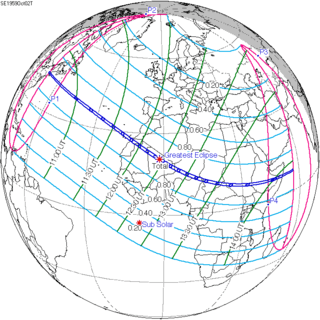 October 2, 1959 Total | |
| 148 | 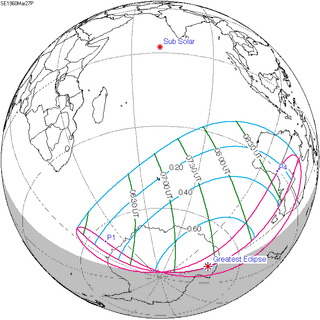 March 27, 1960 Partial |
153 |  September 20, 1960 Partial | |
Saros 133
Solar Saros 133, repeating every 18 years, 11 days, contains 72 events. The series started with a partial solar eclipse on July 13, 1219. It contains annular eclipses from November 20, 1435, through January 13, 1526, with a hybrid eclipse on January 24, 1544. It has total eclipses from February 3, 1562, through June 21, 2373. The series ends at member 72 as a partial eclipse on September 5, 2499. The longest duration of totality was 6 minutes, 50 seconds on August 7, 1850.[2] The total eclipses of this saros series are getting shorter and farther south with each iteration.
| Series members 30-49 occur between 1742 and 2100 | ||
|---|---|---|
| 30 | 31 | 32 |
| June 3, 1742 | June 13, 1760 | 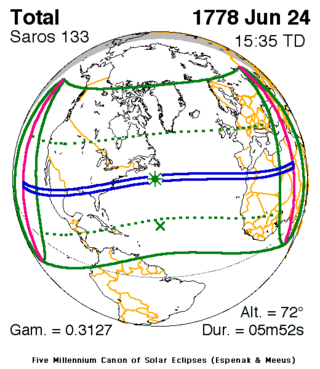 June 24, 1778 |
| 33 | 34 | 35 |
| July 4, 1796 | July 17, 1814 | July 27, 1832 |
| 36 | 37 | 38 |
| August 7, 1850 | 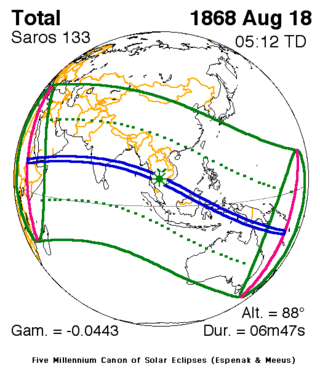 August 18, 1868 |
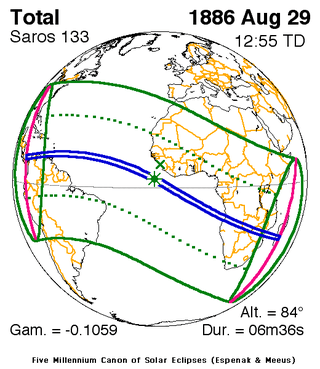 August 29, 1886 |
| 39 | 40 | 41 |
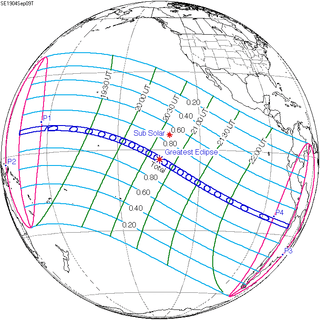 September 9, 1904 |
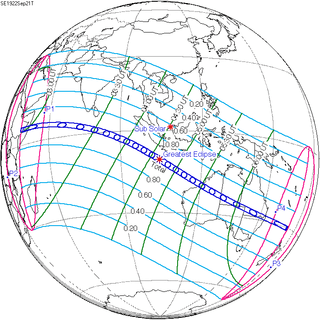 September 21, 1922 |
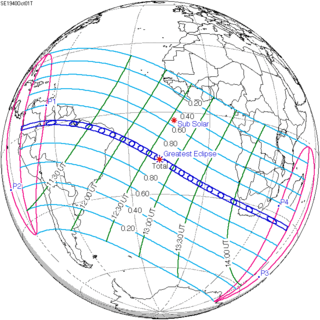 October 1, 1940 |
| 42 | 43 | 44 |
 October 12, 1958 |
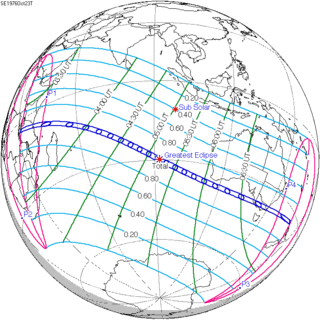 October 23, 1976 |
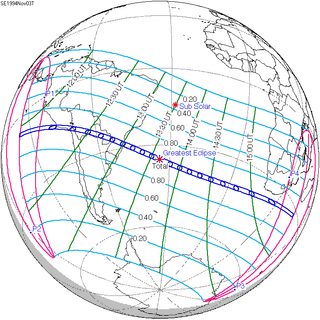 November 3, 1994 |
| 45 | 46 | 47 |
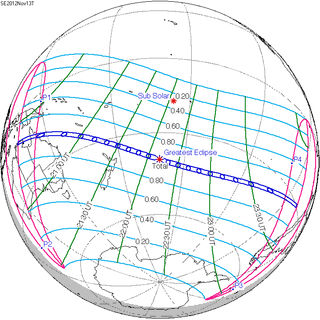 November 13, 2012 |
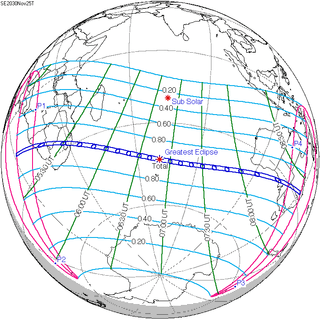 November 25, 2030 |
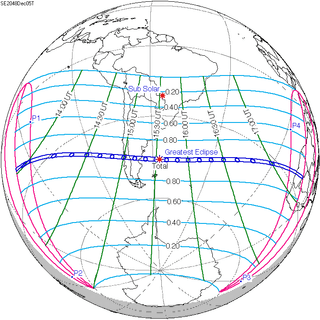 December 5, 2048 |
| 48 | 49 | 50 |
 December 17, 2066 |
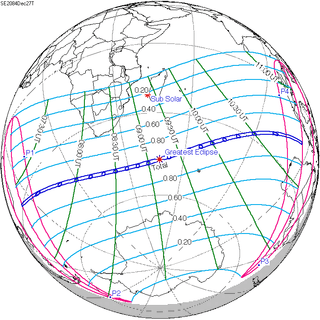 December 27, 2084 |
January 8, 2103 |
Tritos series
This eclipse is a part of a tritos cycle, repeating at alternating nodes every 135 synodic months (≈ 3986.63 days, or 11 years minus 1 month). Their appearance and longitude are irregular due to a lack of synchronization with the anomalistic month (period of perigee), but groupings of 3 tritos cycles (≈ 33 years minus 3 months) come close (≈ 434.044 anomalistic months), so eclipses are similar in these groupings.
| Series members between 1901 and 2100 | |||
|---|---|---|---|
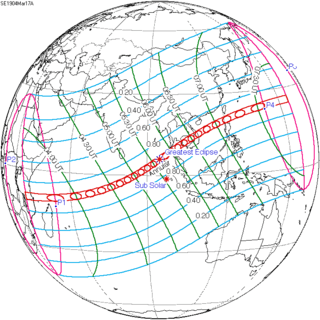 March 17, 1904 (Saros 128) |
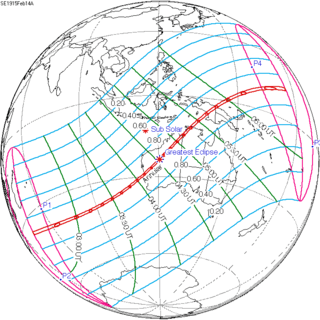 February 14, 1915 (Saros 129) |
 January 14, 1926 (Saros 130) | |
 December 13, 1936 (Saros 131) |
 November 12, 1947 (Saros 132) |
 October 12, 1958 (Saros 133) | |
 September 11, 1969 (Saros 134) |
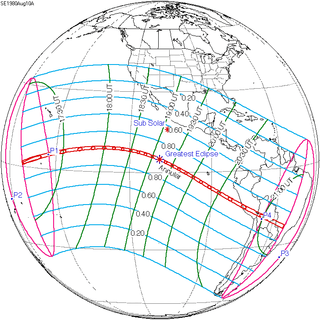 August 10, 1980 (Saros 135) |
 July 11, 1991 (Saros 136) | |
 June 10, 2002 (Saros 137) |
 May 10, 2013 (Saros 138) |
 April 8, 2024 (Saros 139) | |
 March 9, 2035 (Saros 140) |
 February 5, 2046 (Saros 141) |
 January 5, 2057 (Saros 142) | |
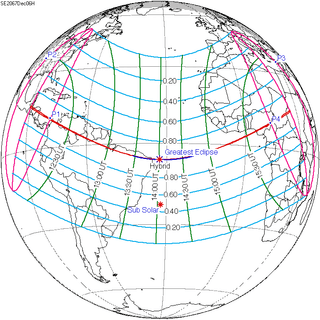 December 6, 2067 (Saros 143) |
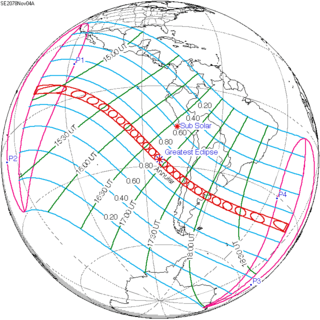 November 4, 2078 (Saros 144) |
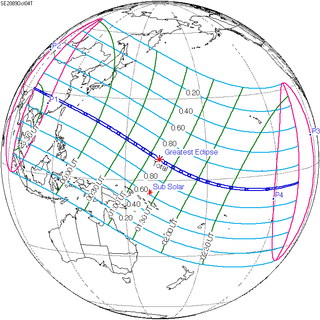 October 4, 2089 (Saros 145) | |
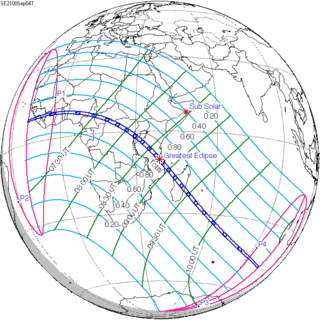 September 4, 2100 (Saros 146) |
|||
Metonic series
The metonic series repeats eclipses every 19 years (6939.69 days), lasting about 5 cycles. Eclipses occur in nearly the same calendar date. In addition, the octon subseries repeats 1/5 of that or every 3.8 years (1387.94 days).
| 21 eclipse events between July 31, 1924 and July 31, 2000 | ||||
|---|---|---|---|---|
| July 31-Aug 1 | May 19-20 | March 7 | December 24-25 | October 12 |
| 115 | 117 | 119 | 121 | 123 |
 July 31, 1924 |
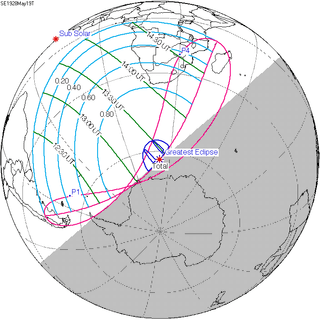 May 19, 1928 |
 March 7, 1932 |
 December 25, 1935 |
 October 12, 1939 |
| 125 | 127 | 129 | 131 | 133 |
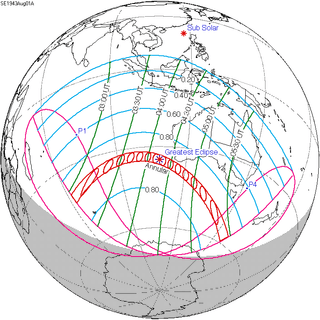 August 1, 1943 |
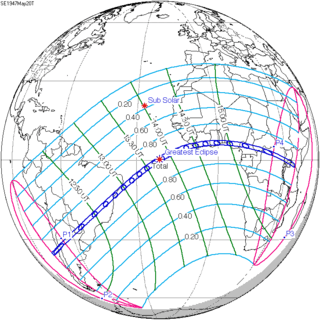 May 20, 1947 |
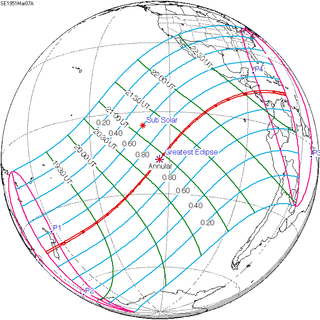 March 7, 1951 |
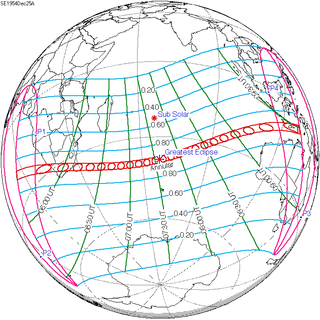 December 25, 1954 |
 October 12, 1958 |
| 135 | 137 | 139 | 141 | 143 |
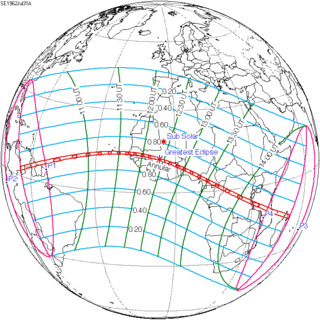 July 31, 1962 |
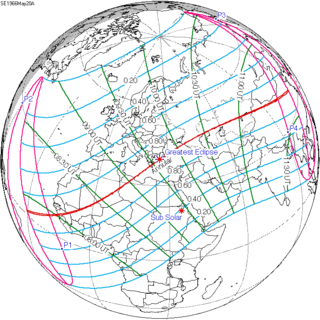 May 20, 1966 |
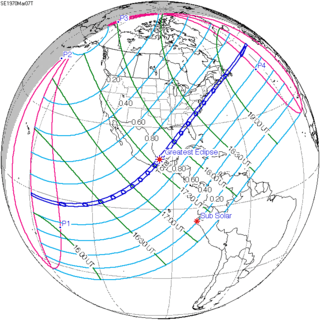 March 7, 1970 |
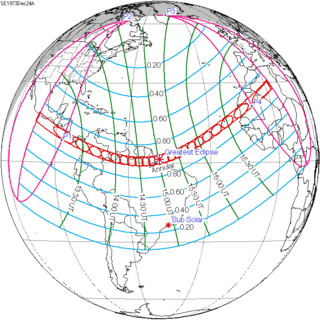 December 24, 1973 |
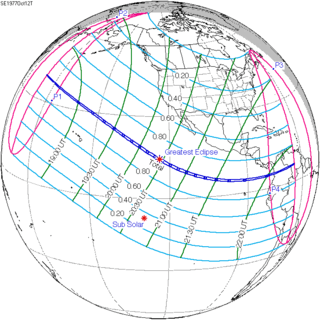 October 12, 1977 |
| 145 | 147 | 149 | 151 | 153 |
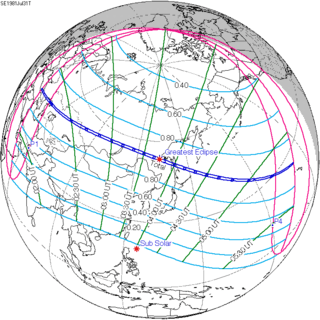 July 31, 1981 |
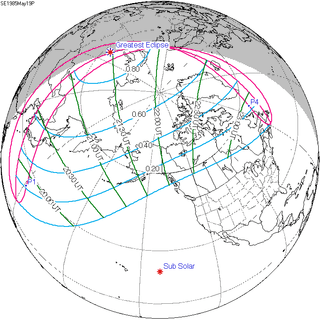 May 19, 1985 |
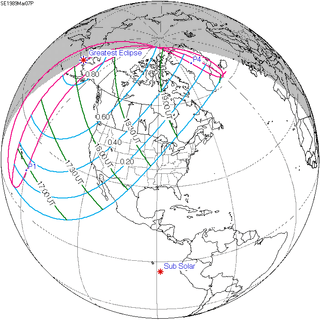 March 7, 1989 |
 December 24, 1992 |
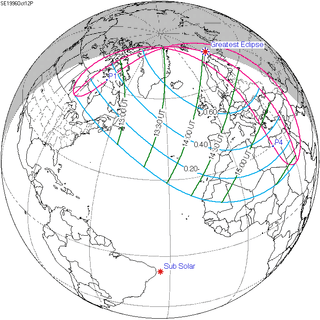 October 12, 1996 |
| 155 | ||||
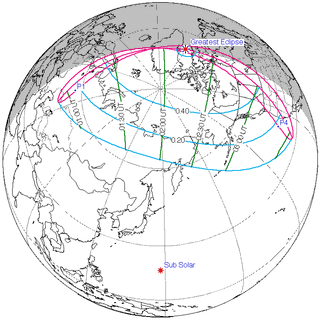 July 31, 2000 | ||||
Notes
- ↑ van Gent, R.H. "Solar- and Lunar-Eclipse Predictions from Antiquity to the Present". A Catalogue of Eclipse Cycles. Utrecht University. Retrieved 6 October 2018.
- ↑ http://eclipse.gsfc.nasa.gov/SEsaros/SEsaros133.html
References
- Earth visibility chart and eclipse statistics Eclipse Predictions by Fred Espenak, NASA/GSFC
| Wikimedia Commons has media related to Solar eclipse of 1958 October 12. |
